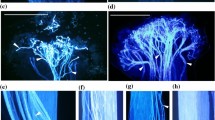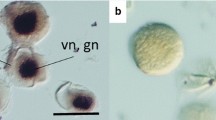Abstract
Here, Nicotiana benthamiana plants became infected with apple stem grooving virus (ASGV) after pollination with pollen grains produced by ASGV-infected apple (Malus pumila) and N. benthamiana plants. Aniline blue staining and fluorescence microscopy revealed that pollen grains from the infected apple and N. benthamiana plants germinated, and their pollen tubes penetrated the stigmas of N. benthamiana, but the apple pollen tubes, unlike the N. benthamiana pollen tubes, stopped elongating in N. benthamiana styles. In a whole-mount in situ hybridization analysis, ASGV was detected in elongating pollen tubes from the ASGV-infected apple and N. benthamiana plants. However, when N. benthamiana stigmas were pollinated with ASGV-infected apple and N. benthamiana pollen grains that could not germinate, ASGV was not detected in any of the pollinated plants. Thus, penetration of the stigma and elongation in the style by pollen tubes harboring the virus results in horizontal pollen transmission of ASGV, and fertilization is not essential for the transmission.



Similar content being viewed by others
References
Adams MJ, Candresse T, Hammond J, Kreuze JF, Martelli GP, Namba S, Pearson MN, Ryu KH, Saldarelli P, Yoshikawa N (2011) Genus Capillovirus. In: King AMQ, Adams MJ, Carstens EB, Lefkowitz EJ (eds) Virus taxonomy, ninth report of the international committee on taxonomy of viruses. Elsevier Academic Press, pp 922–923
Amari K, Burgos L, Pallás V, Sánchez-Pina MA (2007) Prunus necrotic ringspot virus early invasion and its effect on apricot pollen grain performance. Phytopathology 97:892–899
Bhardwaj P, Hallan V (2019a) Occurrence of Apple stem grooving virus on Rubus ellipticus, a perennial weed in India. Eur J Plant Pathol 153:311–319
Bhardwaj P, Hallan V (2019b) Molecular evidence of Apple stem grooving virus infecting Ficus palmata. Trees 33:1–9
Clover GRG, Pearson MN, Elliott DR, Tang Z, Smales TE, Alexander BJR (2003) Characterization of a strain of Apple stem grooving virus in Actinidia chinensis from China. Plant Pathol 52:371–378
Inouye N, Maeda T, Mitsuhata K (1979) Citrus tatter leaf virus isolated from lily. Ann Phytopathol Soc Jpn 45:712–720 (in Japanese with English summary)
Isogai M, Nakamura T, Ujiie C, Watanabe M, Yoshikawa N (2012) Identification and characterization of blueberry latent spherical virus, a new member of subgroup C in the genus Nepovirus. Arch Virol 157:297–303
Isogai M, Yoshida T, Nakanowatari C, Yoshikawa N (2014) Penetration of pollen tubes with accumulated Raspberry bushy dwarf virus into stigmas is involved in initial infection of maternal tissue and horizontal transmission. Virology 452–453:247–253
Isogai M, Yoshida T, Shimura T, Yoshikawa N (2015) Pollen tubes introduce Raspberry bushy dwarf virus into embryo sacs during fertilization processes. Virology 484:341–345
Isogai M, Kamata Y, Ando S, Kamata M, Shirakawa A, Sekine K, Yoshikawa N (2017) Horizontal pollen transmission of gentian ovary ring-spot virus is initiated during penetration of the stigma and style by infected pollen tubes. Virology 503:6–11
Isogai M, Suzuki Y, Matsudaira T, Yoshikawa N (2018) Genomic RNA accumulation of gentian ovary ring-spot virus and raspberry bushy dwarf virus in pollen tubes. J Gen Plant Pathol 84:376–380
Isogai M, Miyoshi K, Watanabe M, Yoshikawa N (2020) Characterization of horizontal transmission of blueberry latent spherical virus by pollen. Arch Virol 165:2807–2815
Kamada K, Omata S, Yamagishi N, Kasajima I, Yoshikawa N (2018) Gentian (Gentiana triflora) prevents transmission of apple latent spherical virus (ALSV) vector to progeny seeds. Planta 248:1431–1441
Kanaoka MM, Kawano N, Matsubara Y, Susaki D, Okuda S, Sasaki N, Higashiyama T (2011) Identification and characterization of TcCRP1, a pollen tube attractant from Torenia concolor. Ann Bot 108:739–747
Kinard GR, Scott SW, Barnett OW (1996) Detection of apple chlorotic leaf spot and apple stem grooving viruses using RT-PCR. Plant Dis 80:616–621
Lister RM (1970) Apple stem grooving virusCMI/AAB. Descriptions of plant viruses No 31. Commonwealth Agricultural Bureaux
Liu Q, Xuan Z, Wu J, Qiu Y, Li M, Zhang S, Wu D, Li R, Cao M (2019) Loquat is a new natural host of apple stem grooving virus and apple chlorotic leaf spot virus in China. Plant Dis 103:3290
Muschietti J, Dircks L, Vancanneyt G, McCormick S (1994) LAT52 protein is essential for tomato pollen development: pollen expressing antisense LAT52 RNA hydrates and germinates abnormally and cannot achieve fertilization. Plant J 6:321–338
Sawamura K, Yamashita K, Arai M (1988) An apple stem grooving virus strain isolated from European pear (Pyrus communis). Bull Fac Agric Hirosaki Univ 50:22–26
Semancik JS, Weathers LG (1965) Partial purification of a mechanically transmissible virus associated with tatter leaf of citrus. Phytopathology 55:1354–1358
Takahashi T, Saito N, Goto M, Kawai A, Namba S, Yamashita S (1990) Apple stem grooving virus isolated from Japanese apricot (Prunus mume) imported from China. Res Bull Plant Prot Jpn 26:15–21 ((in Japanese with English abstract))
Tang J, Olson JD, Ochoa-Corona FM, Clover GRG (2010) Nandina domestica, a new host of Apple stem grooving virus and Alternanthera mosaic virus. Australas Plant Dis Notes 5:25–27
Yamagishi N, Sasaki S, Yoshikawa N (2010) Highly efficient inoculation method of apple viruses to apple seedlings. Julius-Kühn-Archiv 427:226–229
Yanase H (1983) Back-transmission of apple stem grooving virus to apple seedlings and induction of symptoms of apple topworking disease in Mitsuba Kaido (Malus sieboldii) and Kobano Zumi (Malus sieboldii var. arborescens) rootstocks. Acta Hortic 130:117–122
Yoshikawa N, Takahashi T (1988) Properties of RNAs and proteins of apple stem grooving and apple chlorotic leaf spot viruses. J Gen Virol 69:241–245
Yoshikawa N, Sasaki E, Kato M, Takahashi T (1992) The nucleotide sequence of apple stem grooving capillovirus genome. Virology 191:98–105
Yoshikawa N, Sasamoto K, Sakurada M, Takahashi T, Yanase H (1996) Apple stem grooving and citrus tatter leaf capilloviruses obtained from a single shoot of Japanese pear (Pyrus serotina). Ann Phytopathol Soc Jpn 62:119–124
Acknowledgements
This work was supported by JSPS KAKENHI (no. 21K05590).
Author information
Authors and Affiliations
Corresponding author
Ethics declarations
Conflict of interest
The authors declare that they have no conflict of interest.
Ethical approval
This article does not contain any studies with human participants or animals performed by any of the authors.
Additional information
Publisher's Note
Springer Nature remains neutral with regard to jurisdictional claims in published maps and institutional affiliations.
Supplementary Information
Below is the link to the electronic supplementary material.
Rights and permissions
About this article
Cite this article
Isogai, M., Shimoda, R., Nishimura, H. et al. Pollen grains infected with apple stem grooving virus serve as a vector for horizontal transmission of the virus. J Gen Plant Pathol 88, 81–87 (2022). https://doi.org/10.1007/s10327-021-01039-0
Received:
Accepted:
Published:
Issue Date:
DOI: https://doi.org/10.1007/s10327-021-01039-0




